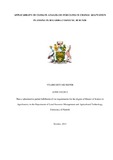Applicability of climate analogues for climate change adaptation planning in Bugabira commune, Burundi
Abstract
Projected impacts of climate change on agriculture in Sub-Saharan Africa are significant and require concrete measures to better understand the anticipated outcomes and address them effectively. The use of climate analogues as a tool to help in climate change impact-response studies is one strategy, where locations that have climatic characteristics similar to those projected are identified. Using the climate analogue analysis approach and field surveys, the project attempted to test the hypothesis that analogue analysis is a useful heuristic tool for adaptation planning. The climate distance method was used where three GCMs, two emission scenarios and three time slices were applied to find a climate analogue for Bugabira Commune (the baseline location). Information relevant to farming systems and adaptation was obtained through interviews involving 450 household heads living in Bugabira (baseline, 247) and Bubanza (analogue, 203) communes in Burundi. Bugabira Commune is in the North West of Burundi and is mainly composed of small-scale farmers who rely on rainfed agriculture for their livelihood. The area has been experiencing severe droughts and unpredictable rainfall patterns that hamper crop production and threaten livelihoods. The information that was collected included data on animals kept, crops grown, various land management practices being carried out and the reasons for these practices and sources of livelihood for the households. Crops grown were mainly beans, cassava, maize, sweet potatoes and bananas while animals kept included cows, goats, pigs and chicken.
The types of crops grown and animals kept could be explained by factors such as market price, productivity, climate, land pressure and pests. Some of the most frequently mentioned climatic hazards were frequency of droughts and floods and declining, unpredictable mean annual rainfall. A greater proportion of farmers in the target location had adopted various land management practices aimed at improving productivity compared to those in the analogue location. Fifty-nine percent of farmers in Bugabira, the baseline location practice contour ploughing compared to 19% at Bubanza, the analogue site. While 68% of farmers at the target site practice crop rotations, a lower 25% of
farmers in the analogue location practice rotations. Eighty-seven percent of farmers at the target site and 58% of farmers in the analogue location apply manure to their farms. Major constraints to agricultural production were related to financial constraints, climate, input accessibility challenges and soil infertility.
In general, farmers in the two locations had adopted similar farming systems and differences could only be observed in the proportions of farmers who were practicing various management strategies, such as growing of drought-tolerant varieties, intercropping and mulching. The disparity in adoption levels could not be directly linked to climate because other factors such as markets and productivity played an overriding role in the decisions made by farmers. The major finding of the research was that systems in the analogue location were not different from those in the baseline as had been anticipated and would therefore not be used as learning grounds for future adaptation in the baseline location. It was thus concluded that the analogue approach should be carefully reviewed before it can be established as a model for future adaptation policy formulation, since it remains unconvincing in its assumption that climate is the main driver of differences in farming systems between sites. This is especially so for African farming systems which respond to a multitude of pressures that are often perceived to be of more importance than climate dynamics.
Citation
Master Of Science In Agroforestry In The Department Of Land Resource Management And Agricultural Technology, University Of Nairobi, 2014Publisher
University of Nairobi

